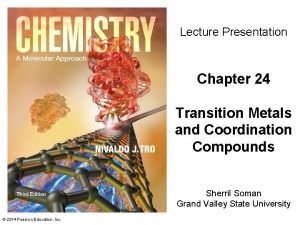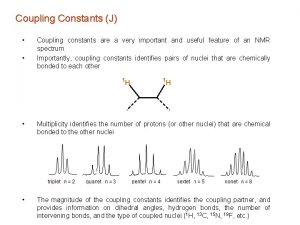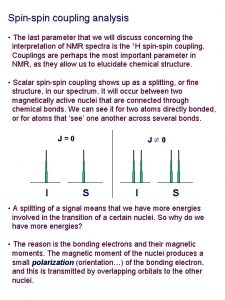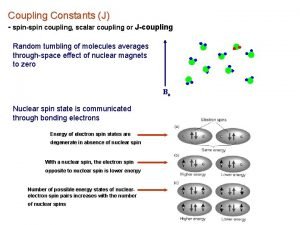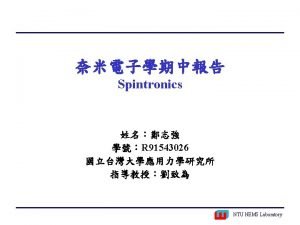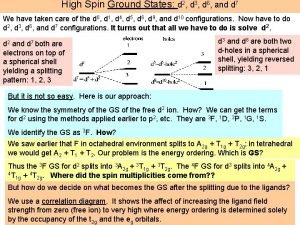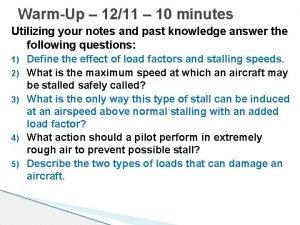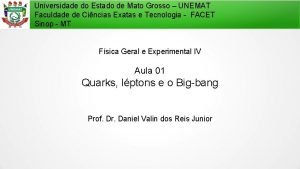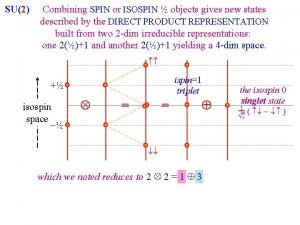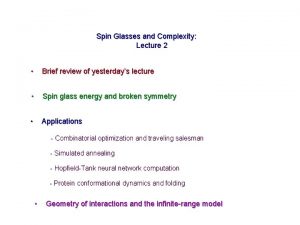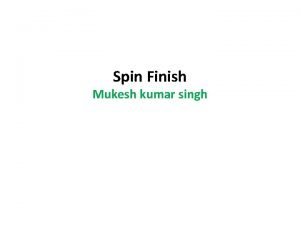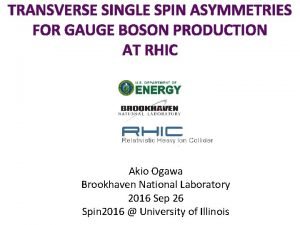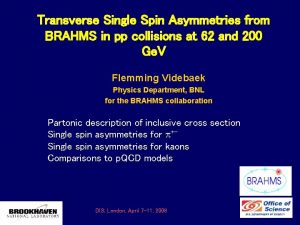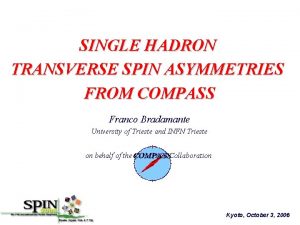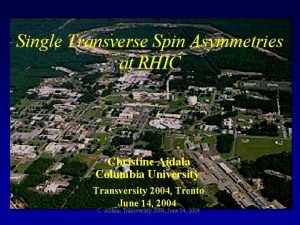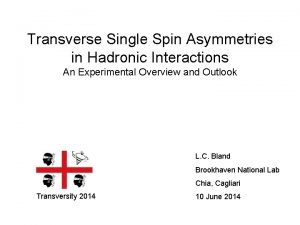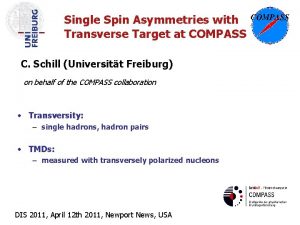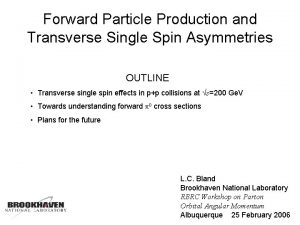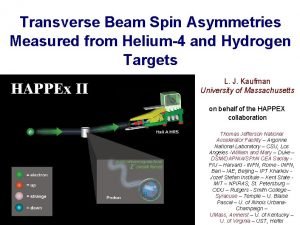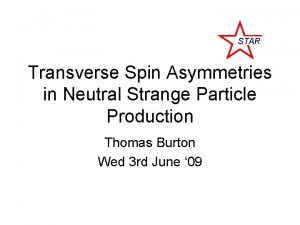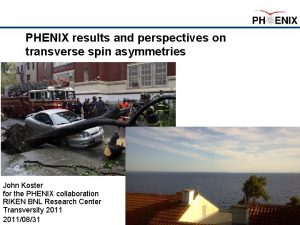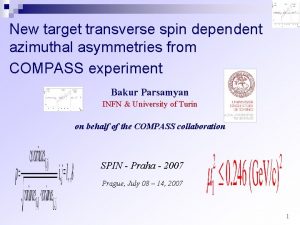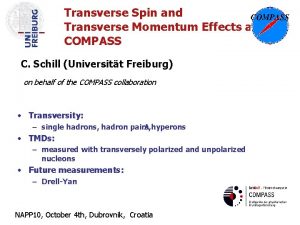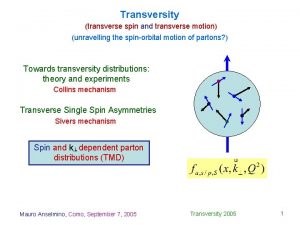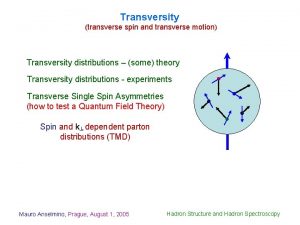Transverse Single Spin Asymmetries at High x F

















- Slides: 17

Transverse Single Spin Asymmetries at High x. F in Mickey Chiu

Transverse Single Spin Asymmetries Definition: where p is the 4 -momentum of a particle (hadron, jet, photon, etc. . . ) Experimentally, there a variety of (~equivalent) ways this can be measured. 1. Yield difference between up/down proton in a single detector Left Right This is susceptible to Rel. Luminosity differences 2. Or, take the left-right difference between 2 detectors This is susceptible to detector Relative Acceptance differences 3. Or, take the cross geometric mean (square-root formula) Mostly insensitive to Relative Luminosity and Detector Acceptance differences 2

Transverse Proton Spin Physics Polarized parton distribution functions quark helicity distribution – known gluon helicity distribution – poorly known transversity distribution – unknown Naïve LO, Leading Twist, p. QCD Result E 704 Helicity violation term due to finite quark masses 3

Transverse Proton Spin Physics • Various possible explanations have been proposed to explain these asymmetries • Transversity x Spin-dep fragmentation (e. g. , Collins effect or IFF), • Intrinsic-k. T in proton (Transverse Momentum Dep Functions) , • Eg, Sivers Function • Perturbative LO Twist-3 Calculations (Qiu-Sterman, Efremov, Koike) • These calculations have been related to the Sivers function A Unified picture for single transverse-spin asymmetries in hard processes, Ji, Qiu, Vogelsang, Yuan PRL 97: 082002, 2006 • Or some combination of the above • Caveat: The theory is still being actively worked out Anim. courtesy J. Kruhwel, JLAB 4

PHENIX at RHIC Spin STAR MPC PHENIX Transversely Polarized p+p Data Set • Central Arm Tracking | | < 0. 35, x. F ~ 0 • Drift Chamber (DC) • momentum measurement • Pad Chambers (PC) • pattern recognition, 3 d space point • Time Expansion Chamber (TEC) • additional resolution at high pt • Central Arm Calorimetry • Pb. Gl and Pb. Sc • Very Fine Granularity • Tower x ~ 0. 01 x 0. 01 • Trigger • Central Arm Particle Id • RICH • electron/hadron separation • TOF • /K/p identification • Global Detectors (Luminosity, Trigger) • BBC 3. 0 < | | < 3. 9 • Quartz Cherenkov Radiators • ZDC/SMD (Local Polarimeter) • Forward Hadron Calorimeter • Forward Calorimetry 3. 1 < | | < 3. 7 • MPC • Pb. WO 4 Crystal • Forward Muon Arms 1. 2 < | | < 2. 4 Run 02 Run 05 Run 06 Run 08 s (Ge. V/c 2) 200 200 62. 4 200 Ldt (pb-1) 0. 15 2. 7 0. 02 5. 2 <P> 0. 15 0. 47 0. 50 ~0. 50 P 2 L 0. 0034 0. 033 0. 87 0. 05 1. 3 5

PHENIX Muon Piston Calorimeter Upgrade SOUTH Density 8. 28 g/cm 3 Size 2. 2 x 18 cm 3 Length 20 X 0, 0. 92 Weight 721. 3 g Moliere radius 2. 0 cm Radiation Length 0. 89 cm Interaction Length 22. 4 cm Light Yield ~10 p. e. /Me. V @ 25 C Temp. Coefficient -2% / C Radiation Hardness 1000 Gy Main Emission Lines 420 -440, 500 nm Refractive Index 2. 16 Small cylindrical hole in Muon Magnet Piston, Radius 22. 5 cm and Depth 43. 1 cm 6

Muon Piston Calorimeter Performance • Shower Reconstruction Using Shower Shape Fits All Pairs Mixed Events Background subtracted • Energy Scale Set by MIP • In Noisy Towers, Used Tower Spectrum MIP Peak • Photon Pair Cuts • Pair Energy > 8 Ge. V • Asymmetry |E 1 -E 2|/|E 1+E 2| < 0. 6 • Noisy Towers in Run 06 (up to 25% of MPC) Excluded • Width ~ 20 Me. V • Confirmed with 0, peaks 7

0 AN at High x. F p +p 0+X at s=62. 4 Ge. V/c 2 3. 0< <4. 0 PLB 603, 173 (2004) process contribution to 0, =3. 3, s=200 Ge. V • Large asymmetries at forward x. F • Valence quark effect? • x. F, p. T, s, and dependence provide quantitative tests for theories 8

RHIC Forward Pion AN at 62. 4 Ge. V E 704, 19. 4 Ge. V, PLB 261, (1991) 201 BRAHMS PRL 101, 042001 PHENIX Preliminary • Brahms Spectrometer at “ 2. 3 ” and “ 3. 0 ” setting < > = 3. 44, comparable to PHENIX all eta • Qualitatively similar behavior to E 704 data: pi 0 is positive and between pi+ and pi-, and roughly similar magnitude: AN(pi+)/AN(pi 0) ~ 25 -50% • Flavor dependence of identified pion asymmetries can help to distinguish between effects • Kouvaris, Qiu, Vogelsang, Yuan, PRD 74: 114013, 2006 • Twist-3 calculation for pions for pion exactly at 3. 3 • Derived from fits to E 704 data at s=19. 4 Ge. V and then extrapolated to 62. 4 and 200 Ge. V • Only qualitative agreement at the moment. Must be very careful in comparisons (between expt’s 9

Comparison to 0 at s = 200 Ge. V/c 2 STAR • Trend with seems to disagree with STAR result, but is consistent with theoretical predictions. • This might just be due to the different collision energy and p. T coverage? 10

Kinematic Cuts and AN Phys. Rev. D 74: 114013, 2006. 5 <3. a t e 5 >3. eta • Mean AN is measured to be lower for p. T>1, even though mean x. F is higher for this p. T bin, and higher x. F implies higher asymmetry • This implies that AN is dropping with pt for a given x. F slice • The cut, for a given x. F slice, splits that slice into high pt and low pt, with the lower eta selecting higher pt • This implies that AN at lower should be smaller, consistent with predictions of PRD 74: 114013 • However, at 62. 4 Ge. V the p. T are low (p. QCD invalid? ) • Cross-section is being analyzed now 11

Run 08 pi 0 E > 6 Ge. V Asymm<0. 6 • A LOT more data is expected from Run 08 • Currently the data processing is in progress at CC-Japan • As of this past Tuesday it was 80% done, still needs to be transferred • Results on pi 0 AN to be expected by early next year • There also other possibilites from this data set… 12

Sivers Fcn from Back 2 Back Analysis 1/Ntrig d. N/d (au) Run 03 -charged dn/d anti-aligned 2 MPC 0 • Boer and Vogelsang find that this parton asymmetry will lead to an asymmetry in the distribution of back-to-back jets • There should be more jets to the left (as in picture to the left). • Should also be able to see this effect with fragments of jets, and not just with fully reconstructed jets • Take some jet trigger particle along ST axis (either aligned or antialigned to ST) • Trigger doesn’t have to be a leading particle, but does have to be a good jet proxy • Then look at distribution of away side particles h, 0 j 1 Boer and Vogelsang, Phys. Rev. D 69: 094025, 2004, hep-ph/0312320 Bomhof, Mulders, Vogelsang, Yuan, PRD 75: 074019, 2007 ST j 2 13

Summary • Much new data coming from transversely polarized proton interactions • p +p (RHIC), but also e+p SIDIS (Hermes, Compass, JLab), e+e- (Belle) • Along with new data on the helicity distribution of partons in the proton (gluon spin), transversely polarized proton collisions could add a wealth of new information on proton structure • Transversity, Orbital angular momentum? 1 -dimensional • GPD’s may be cleanest way to OAM • However, strongest asymmetries are in p +p • PHENIX has measured the transverse asymmetry of 0, h , and J/ , covering an x. F from 0 to 0. 6 (at two different collision energies). • There also sizable asymmetries from proton wave-function forward neutrons out to x. F ~ 1. * • In the future, we expect ~25% of the polarized PHENIX preliminary p+p running will be in the transverse mode • Lots more data coming • New upgrade detectors should significantly enhance physics reach • Nose Cone Calorimeter • Silicon Detectors (SVTX and FVTX) * See Poster by M. Togawa 14

15

2 Future PHENIX Acceptance NCC MPC EMCAL f coverage EMCAL HBD 0 VTX & FVTX -3 -2 -1 0 1 2 3 • History – PHENIX is a small acceptance, high rate, rare probes (photons, J/Psi, etc. ) detector • Future – Add acceptance and add some new capabilities (hadron blind, displaced vertex) • Muon Piston Calorimeter (2006 -end): Pb. WO 4 Electromagnetic Calorimeter • Hadron Blind Detector (2007 -2009): Cs. I Triple GEM Cerenkov Detector • Nose Cone Calorimeter (2010 -end): Tungsten-Silicon Electromagnetic Calorimeter with limited Jet Capabilities (1 arm, possibly 2 with funding) • SVTX (2009 -end): Central Arm Silicon Tracker • FVTX (2010 -end): Muon Arm Silicon Tracker 16

17
 Low spin and high spin complex
Low spin and high spin complex Coupling constant nmr
Coupling constant nmr Spin spin coupling
Spin spin coupling Spin spin coupling
Spin spin coupling 優點
優點 Peritoneal cavity,
Peritoneal cavity, Lfae for high spin d3 system is
Lfae for high spin d3 system is Sisd example
Sisd example Dataxin
Dataxin Waiting line management system
Waiting line management system Can you recover from a flat spin
Can you recover from a flat spin Spin inteiro
Spin inteiro Spin vragen voorbeelden
Spin vragen voorbeelden The last spin short story
The last spin short story Combined spin
Combined spin Spin selling questions
Spin selling questions Spin glasses and complexity
Spin glasses and complexity Spin finish oil formulation
Spin finish oil formulation
